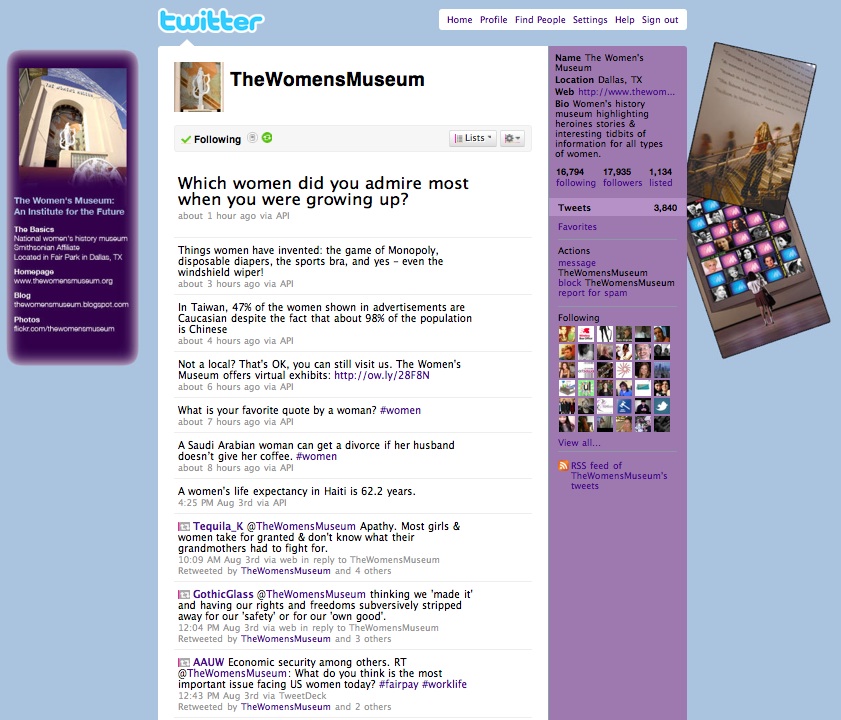CASE STUDY: The Women's Museum
Organization: The Women’s Museum: An Institute for the Future | www.TheWomensMuseum.org Background: A Smithsonian affiliate, The Women’s Museum: An Institute for the Future, makes visible the unique, textured and diverse stories of American women. Using the latest technology and interactive media, the Museum’s exhibits and programs expand our understanding of women’s participation in shaping our nation’s history and create a lively environment for dialogue and discovery. Thousands of stories recount public and private triumphs and the struggles of those who would be denied their freedoms in all its forms: political, social and spiritual.
Business Need: Maximize national exposure with a minimal budget, being a non-profit organization.
Social Media Solution: Twitter.com/TheWomensMuseum
Business Result: A rapidly growing national and international brand awareness.
What actually happened: Even before you walk into The Women’s Museum in Dallas, Texas, the indomitable beauty of its elegant art deco façade immediately overcomes you. When you enter the blissfully cool lobby and walk up the grand stairway, you pass the larger-than-life ‘Wall of Words,’ where a dozen quotes are presented from the most inspiring women in history – Susan B. Anthony, Eleanor Roosevelt, Mary McLeod Bethune. Further exploration of the Museum yields the many stories of women that take place throughout U.S. history from 1500 to now, all presented in an awe-inducing venue that harnesses the power of interactive media. For example, users can watch videos of The Carol Burnett Show and listen to audio recordings of Aretha Franklin’s four-octave voice.
Visitors can open drawers to discover hundreds of pop culture images in the ‘Icons of Womanhood’ section, or peruse the dynamic ‘It’s Amazing’ section. This colorful, brightly lit glass labyrinth explores facts and fiction of past and present dealing with stereotypes and images.
For such a highly interactive and intricate multimedia experience to not garner a national audience would be a waste, and yet prior to 2008, that was precisely the situation facing the nine-year-old institution. “Here we were,” says Lyn Scott, COO at The Women’s Museum, “the only museum in the nation dedicated to American women’s history, and yet we had no means of speaking to a national audience.”
The mission of The Women’s Museum was to “bring to life the voices, talents, achievements, aspirations and stories of the past, present and future;” to be appreciated on a national level. However, it faced the problems common to most non-profits. Limited resources meant limited staff, especially for the marketing department, which consisted of one person. And like most non-profits, marketing had to make do with a slim advertising budget of virtually zero dollars.
“We were only able to justify buying ad space in smaller, regional magazines focusing on local tourism and rental events,” says Haley Curry, Marketing Manager of The Women’s Museum. Not surprisingly, this kind of geographically narrow focus provided limited exposure. Prior to the advent of social media, the Museum’s website was its only means of reaching a wider audience, yet it was still limited in its reach. Along came Twitter. Thanks to its ability to reach a wide audience and engage with fans from all over the U.S. and the world, the Museum quickly realized the potential of this new platform. “Twitter allowed us to make huge strides on a limited budget,” says Curry.
Using only the highest-quality content that was a blend of both entertainment and information, the Museum was able to build a strong community of Twitter followers. Within the first year, The Women’s Museum’s social media outreach campaign was a huge success, attaining an impressive 12,000+ Twitter followers. Furthermore, @TheWomensMuseum is ranked among the Top Museums on Twitter along with the Tate in London, MoMa and the Brooklyn Museum (http://ow.ly/3bVWd) as well as being on the list of 20 of the Top Non-profits to Follow on Twitter.

The most critical result of their efforts: About 60% of The Women’s Museum’s followers are located outside the Dallas/Fort Worth area, with 1% located internationally. The Women’s Museum has achieved a strong presence and awareness, which continues to grow, not just nationally but internationally as well. “Twitter also allows us to connect with our most enthusiastic fans and participate in a conversation that is constructive to our mission: create conversation and develop understanding of American women’s history,” says Curry.
That connection is critical for a museum with such interactive media exhibits that bridge the gap between location and thought. “Not everyone can visit The Women’s Museum the building, but they can experience who we are daily at @TheWomensMuseum.”
